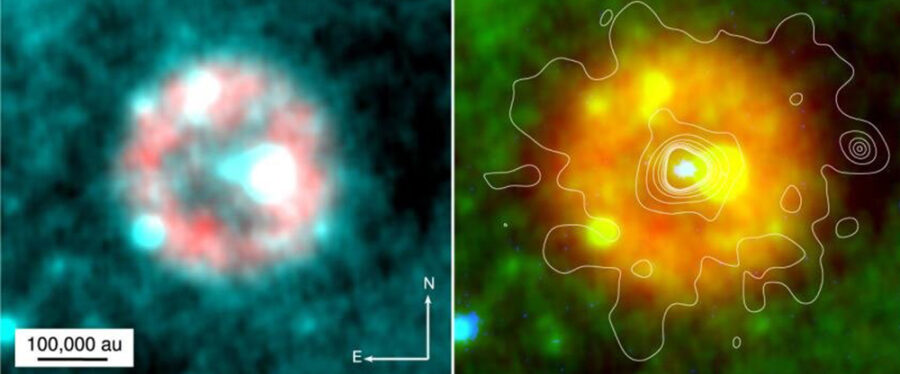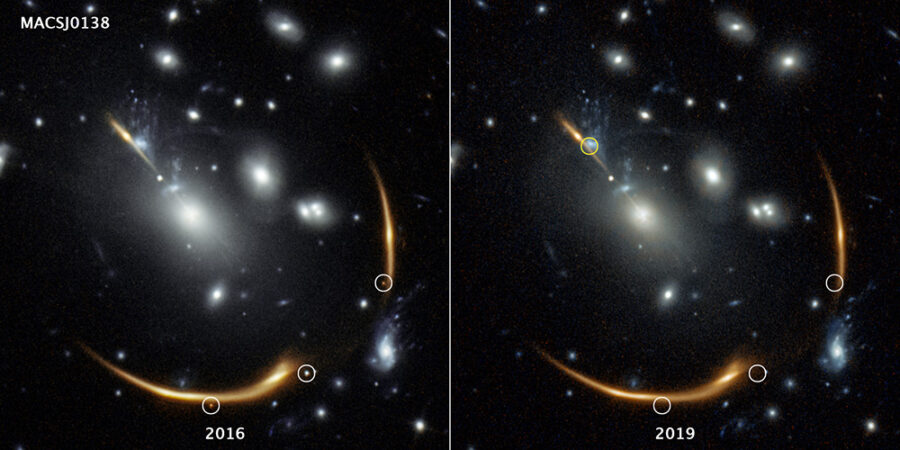This week, astronomers have solved one supernova mystery and predicted a new one — to be solved in 2037.
Solving a 900-year-old Supernova Mystery

Andreas Ritter et al. / Astrophysical Journal Letters
Almost a millenium ago, in 1181 AD, Chinese astronomers noted a "guest star" that appeared as bright as Saturn in their skies. This guest marked a supernova that gradually dimmed over the next six months before disappearing from naked-eye view. But even though they recorded an approximate location on the sky, no modern astronomer has been able to identify the supernova source.
Now, Albert Zijlstra (University of Manchester, UK) and colleagues announce the detection of the gaseous remnants of a supernova, a giant bubble expanding at about 1,100 km/s (2.5 million mph). Dana Patchick, part of the Deep-Sky Hunters amateur astronomer group, found the nebula in Wide-field Infared Survey Explorer (WISE) images.
Based on the current rate of expansion, the team estimates the gases originated in a supernova explosion some 1,000 years ago, at a point near the recorded location of the ancient guest star.
The supernova was likely the merger of two white dwarfs in a type of explosion astronomers classify as Type Iax, a rare beast that makes up only 10% of the supernova menagerie. The merger left behind an extreme stellar remnant that the researchers have dubbed "Parker's Star."
Read more about the Chinese guest star of 1181 in the University of Manchester press release and the study appearing in the September 10th Astrophysical Journal Letters.
Supernova Reprise

Steve A. Rodney (University of South Carolina), Gabriel Brammer (University of Copenhagen); Image processing: Joseph DePasquale (STScI)
Ten billion years ago, a star exploded. Its photons journeyed through the universe, passing through a massive galaxy cluster some 6 billion years later. The gravity of those galaxies and their attendant retinues of hot gas acted like a cosmic lens, bending and magnifying the supernova's light, distorting it until it became multiple images.
Those images appeared in a Hubble Space Telescope photo in 2016 before fading away. By 2019, there was no visible remnant of the supernova, dubbed Requiem.
But we'll see Requiem again. By the way the cluster has bent the background light, astronomers predict that some photons took a fourth, longer path, and they'll take another 16 years to arrive. In 2037, astronomers will see if they're right.
Gravitationally lensed supernovae have been observed before (Supernova Refsdal and iPTF16geu are two notable examples), but the more of them the better. Because their light takes multiple paths to Earth, they are powerful probes of cosmology, giving astronomers an independent measure of the much-debated current expansion rate of the universe.
Read more about Supernova Requiem in the Hubble press release and in this week's Nature Astronomy.
 7
7
Comments
Anthony Barreiro
September 18, 2021 at 5:58 pm
From the ApJL article, the proposed remnant of the Chinese supernova of 1181 CE is at right ascension 0 hours 53 minutes and declination +67 degrees 30 arcminutes, in Cassiopeia, at a distance of 7500 light years. I'm always curious where things are in the sky, and how far away they are.
You must be logged in to post a comment.
Andrew James
September 18, 2021 at 9:12 pm
SN 1181A appears in the Historical Supernova plug-in in Stellarium 21.0. It peaked in brightness on 4 August 1181 at about -2.0 magnitude. Position is given as 02h 05.6m +64° 50' (2000) or 01h 09.2m +60° 40' (1181), some 1.5°SW (PA 228°) from Epsilion Cas - the faintest star of Cassiopeia's "W" or her dutiful chair. The new position is 7.7°WNW (PA 293°) away from above or roughly 6.6°N of Gamma Cas. Stellarium says 8500 lys.
As to you comment... Agreed. It more astounds me across the wide gambit of astronomical media continues the practice of not indicating celestial positions. Anyone would think that if you create a paper on a particular object that the reader can research further about it. That you can't readily even find this information on SIMBAD or even a general internet search - other than multitudes of media articles based on the press release (whose authors rarely investigate further about it) - that also leave out RA, Dec, Constellation or a prime SIMBAD designation.
Perhaps the IAU should compel the professional journals to include in the header via their Style Guides such data, which can easily be adopted into a standardised LaTeX format.
Note: I have been told by some authors that they have been advised not to do this because it somehow undermines their astrophysical research. Ergo, makes it too easy to find comparison objects they might have missed or reduces the number of future cites. I've never really understood why authors seem so fearful to disclose such basic information.
You must be logged in to post a comment.
robin_astro
September 24, 2021 at 7:00 pm
No conspiracy theory here. Just go to the paper and you will find the star in question is IRAS 00500+6713. Here is the link to in CDS
http://cdsportal.u-strasbg.fr/?target=%20IRAS%2000500%2B6713
and here is a spectrum I took of it the other night (noisy under a bright moon - I will come back to it)
https://britastro.org/specdb/data_graph.php?obs_id=10444
The original spectrum that prompted a closer look was also taken by an amateur who is a co-author
You must be logged in to post a comment.
robin_astro
September 24, 2021 at 7:12 pm
Here is his story on the ARAS spectroscopy forum
http://www.spectro-aras.com/forum/viewtopic.php?f=6&t=2822
You must be logged in to post a comment.
Andrew James
September 25, 2021 at 9:56 pm
'No conspiracy theory here."
None is implied. My point is linking the media releases or general stories to the object in question. My own broad interest in astronomy often goes to look more deeply into the phenomena, and look at the historical context or if the object is observable or can be imaged in telescopes, or even if it is visible from my location. Does the novice astro know was IRAS or 2MASS means when their mindset in by constellation, RA & Dec? My point.
Yes, a basic search engine finds IRAS 00500+6713 many times, but this S&T story does not mention this designation.
Note: Also IRAS targets are in B1950 coordinates.
You must be logged in to post a comment.
robin_astro
September 26, 2021 at 11:17 am
"Note: I have been told by some authors that they have been advised not to do this because it somehow undermines their astrophysical research. Ergo, makes it too easy to find comparison objects they might have missed or reduces the number of future cites. I've never really understood why authors seem so fearful to disclose such basic information."
Certainly sounds like a conspiracy theory to me. Reproducibility underpins scientific research. Can you cite an example of a peer reviewed paper which fails to disclose enough information to identify and observe the object in question? This one certainly does as I demonstrated.
IRAS 00500+6713 is the main identifier in SIMBAD. The notation is not meant to be an exact coordinate, just an identifier in the IRAS catalogue. The coordinates (along with all alternative names and a list of references) can be found in SIMBAD from the CDS portal link above which is a bookmark I recommend for anyone interested in finding out more about a particular object.
Now if you had complained about the press stories which fail to give a reference for the original source then I would agree. Happily S&T do
You must be logged in to post a comment.
Andrew James
September 27, 2021 at 5:25 am
Just an observation Complex names are a turn-off, so press releases just avoid them. I wish I had a dollar for all the time I've spent reading some object inside some paper or article just to find out where it is in the sky - and is a problem that needs standardisation. Maybe my search pattern might be askew, but it does seem sometimes too difficult in searching for objects.
You must be logged in to post a comment.
You must be logged in to post a comment.